Contents
[hide]- 1 History
- 2 Uses for bicycles
- 3 Technical aspects
- 4 Social and historical aspects
- 5 See also
- 6 Notes
- 7 References
- 8 External links


The bicycle, cycle, or bike is a pedal-driven, human-powered vehicle with two wheels attached to a frame, one behind the other.
Bicycles were introduced in the 19th century and now number about one billion worldwide.[1] They are the principal means of transportation in many regions. They also provide a popular form of recreation, and have been adapted for such uses as children's toys, adult fitness, military and police applications, courier services, and competitive sports.
The basic shape and configuration of a typical bicycle has changed little since the first chain-driven model was developed around 1885.[2] Many details have been improved, especially since the advent of modern materials and computer-aided design. These have allowed for a proliferation of specialized designs for particular types of cycling.
The bicycle has had a considerable effect on human society, in both the cultural and industrial realms. In its early years, bicycle construction drew on pre-existing technologies; more recently, bicycle technology has, in turn, contributed both to old and new areas.
[edit] History
Several innovators contributed to the history of the bicycle by developing precursor human-powered vehicles. The documented ancestors of today's modern bicycle were known as push bikes, Draisines or hobby horses. Being the first human means of transport to make use of the two-wheeler principle, the draisine (or Laufmaschine, "running machine"), invented by the German Baron Karl von Drais, is regarded as the archetype of the bicycle. It was introduced by Drais to the public in Mannheim in summer 1817 and in Paris in 1818.[3] Its rider sat astride a wooden frame supported by two in-line wheels and pushed the vehicle along with his/her feet while steering the front wheel.
In the early 1860s, Frenchmen Pierre Michaux and Pierre Lallement took bicycle design in a new direction by adding a mechanical crank drive with pedals on an enlarged front wheel. Several why-not-the-rear-wheel inventions followed, the best known being the rod-driven velocipede by Scotsman Thomas McCall in 1869. The French creation, made of iron and wood, developed into the "penny-farthing" (more formally an "ordinary bicycle", a retronym, since there were then no other kind).[4] It featured a tubular steel frame on which were mounted wire spoked wheels with solid rubber tires. These bicycles were difficult to ride due to their very high seat and poor weight distribution.
The dwarf ordinary addressed some of these faults by reducing the front wheel diameter and setting the seat further back. This necessitated the addition of gearing, effected in a variety of ways, to attain sufficient speed. Having to both pedal and steer via the front wheel remained a problem. Starley's nephew, J. K. Starley, J. H. Lawson, and Shergold solved this problem by introducing the chain drive (originated by Henry Lawson's unsuccessful "bicyclette"),[5] connecting the frame-mounted pedals to the rear wheel. These models were known as dwarf safeties, or safety bicycles, for their lower seat height and better weight distribution. Starley's 1885 Rover is usually described as the first recognizably modern bicycle. Soon, the seat tube was added, creating the double-triangle diamond frame of the modern bike.
Further innovations increased comfort and ushered in a second bicycle craze, the 1890s' Golden Age of Bicycles. In 1888, Scotsman John Boyd Dunlop introduced the pneumatic tire, which soon became universal. Soon after, the rear freewheel was developed, enabling the rider to coast. This refinement led to the 1898 invention of coaster brakes. Derailleur gears and hand-operated cable-pull brakes were also developed during these years, but were only slowly adopted by casual riders. By the turn of the century, cycling clubs flourished on both sides of the Atlantic, and touring and racing became widely popular.
Bicycles and horse buggies were the two mainstays of private transportation just prior to the automobile, and the grading of smooth roads in the late 19th Century was stimulated by the widespread advertising, production, and use of these devices.
[edit] Uses for bicycles
Bicycles have been and are employed for many uses:
- Utility: bicycle commuting and utility cycling
- Work: mail delivery, paramedics, police, and general delivery.
- Recreation: bicycle touring, mountain biking, BMX and physical fitness.
- Racing: track racing, criterium, roller racing and time trial to multi-stage events like the Tour of California, Giro d'Italia, the Tour de France, the Vuelta a España, the Volta a Portugal, among others.
- Military: scouting, troop movement, supply of provisions, and patrol. See bicycle infantry.
- Show: entertainment and performance, e.g. circus clowns
Cycling has many health benefits and does not directly contribute to global warming or air pollution.[citation needed]
[edit] Technical aspects
The bicycle has undergone continual adaptation and improvement since its inception. These innovations have continued with the advent of modern materials and computer-aided design, allowing for a proliferation of specialized bicycle types.
[edit] Types of bicycles
Bicycles can be categorized in different ways: e.g. by function, by number of riders, by general construction, by gearing or by means of propulsion. The more common types include utility bicycles, mountain bicycles, racing bicycles, touring bicycles, hybrid bicycles, cruiser bicycles, and BMX bicycles. Less common are tandems, lowriders, tall bikes, fixed gear (fixed-wheel), folding models and recumbents (one of which was used to set the IHPVA Hour record).
Unicycles, tricycles and quadracycles are not strictly bicycles, as they have respectively one, three and four wheels, but are often referred to informally as "bikes".
[edit] Dynamics
A bicycle stays upright by being steered so as to keep its center of gravity over its wheels. This steering is usually provided by the rider, but under certain conditions may be provided by the bicycle itself.
A bicycle must lean in order to turn. This lean is induced by a method known as countersteering, which can be performed by the rider turning the handlebars directly with the hands or indirectly by leaning the bicycle.
Short-wheelbase or tall bicycles, when braking, can generate enough stopping force at the front wheel in order to flip longitudinally. The act of purposefully using this force to lift the rear wheel and balance on the front without tipping over is a trick known as a stoppie, endo or front wheelie.
[edit] Performance

The bicycle is extraordinarily efficient in both biological and mechanical terms. The bicycle is the most efficient self-powered means of transportation in terms of energy a person must expend to travel a given distance.[6] From a mechanical viewpoint, up to 99% of the energy delivered by the rider into the pedals is transmitted to the wheels, although the use of gearing mechanisms may reduce this by 10-15%.[7][8] In terms of the ratio of cargo weight a bicycle can carry to total weight, it is also a most efficient means of cargo transportation.
A human being traveling on a bicycle at low to medium speeds of around 10-15 mph (15-25 km/h), using only the energy required to walk, is the most energy-efficient means of transport generally available. Air drag, which is proportional to the square of speed, requires dramatically higher power outputs as speeds increase. A bicycle which places the rider in a seated position, supine position or, more rarely, prone position, and which may be covered in an aerodynamic fairing to achieve very low air drag, is referred to as a recumbent bicycle or human powered vehicle. On an upright bicycle, the rider's body creates about 75% of the total drag of the bicycle/rider combination.
In addition, the carbon dioxide generated in the production and transportation of the food required by the bicyclist, per mile traveled, is less than 1/10th that generated by energy efficient cars.[9]
[edit] Construction and parts
In its early years, bicycle construction drew on pre-existing technologies. More recently, bicycle technology has in turn contributed ideas in both old and new areas.
[edit] Frame
The great majority of today's bicycles have a frame with upright seating which looks much like the first chain-driven bike.[2] Such upright bicycles almost always feature the diamond frame, a truss consisting of two triangles: the front triangle and the rear triangle. The front triangle consists of the head tube, top tube, down tube and seat tube. The head tube contains the headset, the set of bearings that allows the fork to turn smoothly for steering and balance. The top tube connects the head tube to the seat tube at the top, and the down tube connects the head tube to the bottom bracket. The rear triangle consists of the seat tube and paired chain stays and seat stays. The chain stays run parallel to the chain, connecting the bottom bracket to the rear dropouts. The seat stays connect the top of the seat tube (at or near the same point as the top tube) to the rear dropouts.
Historically, women's bicycle frames had a top tube that connected in the middle of the seat tube instead of the top, resulting in a lower standover height at the expense of compromised structural integrity, since this places a strong bending load in the seat tube, and bicycle frame members are typically weak in bending. This design, referred to as a step-through frame, allows the rider to mount and dismount in a dignified way while wearing a skirt or dress. While some women's bicycles continue to use this frame style, there is also a variation, the mixte, which splits the top tube into two small top tubes that bypass the seat tube and connect to the rear dropouts. The ease of stepping through is also appreciated by those with limited flexibility or other joint problems. Because of its persistent image as a "women's" bicycle, step-through frames are not common for larger frames.
Another style is the recumbent bicycle. These are inherently more aerodynamic than upright versions, as the rider may lean back onto a support and operate pedals that are on about the same level as the seat. The world's fastest bicycle is a recumbent bicycle but this type was banned from competition in 1934 by the Union Cycliste Internationale[10].
Historically, materials used in bicycles have followed a similar pattern as in aircraft, the goal being high strength and low weight. Since the late 1930s alloy steels have been used for frame and fork tubes in higher quality machines. Celluloid found application in mudguards, and aluminum alloys are increasingly used in components such as handlebars, seat post, and brake levers. In the 1980s aluminum alloy frames became popular, and their affordability now makes them common. More expensive carbon fiber and titanium frames are now also available, as well as advanced steel alloys and even bamboo.
[edit] Drivetrain and gearing
- For more details on this topic, see bicycle gearing.
Since cyclists' legs are most efficient over a narrow range of pedalling speeds (cadence), a variable gear ratio helps a cyclist to maintain an optimum pedalling speed while covering varied terrain. As a first approximation, utility bicycles often use a hub gear with a small number (3 to 5) of widely-spaced gears, road bicycles and racing bicycles use derailleur gears with a moderate number (10 to 16) of closely-spaced gears, while mountain bicycles, hybrid bicycles, and touring bicycles use dérailleur gears with a larger number (15 to 30) of moderately-spaced gears, often including an extremely low gear (granny gear) for climbing steep hills.
Different gears and ranges of gears are appropriate for different people and styles of cycling. Multi-speed bicycles allow gear selection to suit the circumstances, e.g. it may be comfortable to use a high gear when cycling downhill, a medium gear when cycling on a flat road, and a low gear when cycling uphill. In a lower gear every turn of the pedals leads to fewer rotations of the rear wheel. This allows the force required to move the same distance to be distributed over more pedal turns, reducing fatigue when riding uphill, with a heavy load, or against strong winds. A higher gear allows a cyclist to make fewer pedal cycles to maintain a given speed, but with more effort per turn of the pedals.
The drivetrain begins with pedals which rotate the cranks, which are held in axis by the bottom bracket. Most bicycles use a chain to transmit power to the rear wheel. A relatively small number of bicycles use a shaft drive to transmit power. A very small number of bicycles (mainly single-speed bicycles intended for short-distance commuting) use a belt drive as an oil-free way of transmitting power.
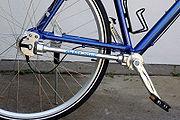
With a chain drive transmission, a chainring attached to a crank drives the chain, which in turn rotates the rear wheel via the rear sprocket(s) (cassette or freewheel). There are four gearing options: two-speed hub gear integrated with chain ring, up to 3 chain rings, up to 10 sprockets, hub gear built in to rear wheel (3-speed to 14-speed). The most common options are either a rear hub or multiple chain rings combined with multiple sprockets (other combinations of options are possible but less common).
With a shaft drive transmission, a gear set at the bottom bracket turns the shaft, which then turns the rear wheel via a gear set connected to the wheel's hub. There is some small loss of efficiency due to the two gear sets needed. The only gearing option with a shaft drive is to use a hub gear.
[edit] Steering and seating

The handlebars turn the fork and the front wheel via the stem, which rotates within the headset. Three styles of handlebar are common. Upright handlebars, the norm in Europe and elsewhere until the 1970s, curve gently back toward the rider, offering a natural grip and comfortable upright position. Drop handlebars are "dropped", offering the cyclist either an aerodynamic "crouched" position or a more upright posture in which the hands grip the brake lever mounts. Mountain bikes feature a straight handlebar which can provide better low-speed handling due to the wider nature of the bars.
Saddles also vary with rider preference, from the cushioned ones favored by short-distance riders to narrower saddles which allow more room for leg swings. Comfort depends on riding position. With comfort bikes and hybrids the cyclist sits high over the seat, their weight directed down onto the saddle, such that a wider and more cushioned saddle is preferable. For racing bikes where the rider is bent over, weight is more evenly distributed between the handlebars and saddle, the hips are flexed, and a narrower and harder saddle is more efficient. Differing saddle designs exist for male and female cyclists, accommodating the genders' differing anatomies, although bikes typically are sold with saddles most appropriate for men.
A recumbent bicycle has a reclined chair-like seat that some riders find more comfortable than a saddle, especially riders who suffer from certain types of seat, back, neck, shoulder, or wrist pain. Recumbent bicycles may have either under-seat or over-seat steering.
[edit] Brakes

Modern bicycle brakes are either rim brakes, in which friction pads are compressed against the wheel rims, internal hub brakes, in which the friction pads are contained within the wheel hubs, or disc brakes. Disc brakes are common on off-road bicycles, tandems and recumbent bicycles.

With hand-operated brakes, force is applied to brake levers mounted on the handlebars and transmitted via Bowden cables or hydraulic lines to the friction pads. A rear hub brake may be either hand-operated or pedal-actuated, as in the back pedal coaster brakes which were popular in North America until the 1960s, and are still common in children's bicycles.
Track bicycles do not have brakes. Brakes are not required for riding on a track because all riders ride in the same direction around a track which does not necessitate sharp deceleration. Track riders are still able to slow down because all track bicycles are fixed-gear, meaning that there is no freewheel. Without a freewheel, coasting is impossible, so when the rear wheel is moving, the crank is moving. To slow down one may apply resistance to the pedals.
[edit] Suspension
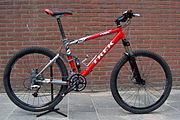
Bicycle suspension refers to the system or systems used to suspend the rider and all or part of the bicycle. This serves two purposes:
- To keep the wheels in continuous contact with rough surfaces in order to improve control.
- To isolate the rider and luggage from jarring due to rough surfaces.
Bicycle suspensions are used primarily on mountain bicycles, but are also common on hybrid bicycles, and can even be found on some road bicycles, as they can help deal with problematic vibration. Suspension is especially important on recumbent bicycles, since while an upright bicycle rider can stand on the pedals to achieve some of the benefits of suspension, a recumbent rider cannot.
[edit] Wheels
A bicycle wheel is almost always built up from a hub, rim, and spokes, and fitted with rubber pneumatic tires.
The wheel axle fits into dropouts in the frame and forks. A pair of wheels may be called a wheelset, especially in the context of ready-built "off the shelf", performance-oriented wheels.
Tires vary enormously. Skinny, road-racing tires may be completely smooth, or (slick). On the opposite extreme, off-road tires are much wider and thicker, and usually have a deep tread for gripping in muddy conditions.
[edit] Accessories, repairs, and tools

Some components, which are often optional accessories on sports bicycles, are standard features on utility bicycles to enhance their usefulness and comfort. Mudguards, or fenders, protect the cyclist and moving parts from spray when riding through wet areas and chainguards protect clothes from oil on the chain while preventing clothing from being caught between the chain and crankset teeth. Kick stands keep a bicycle upright when parked. Front-mounted baskets for carrying goods are often used. Luggage carriers and panniers mounted above the rear tire can be used to carry equipment or cargo. Parents sometimes add rear-mounted child seats and/or an auxiliary saddle fitted to the crossbar to transport children.
Toe-clips and toestraps and clipless pedals help keep the foot locked in the proper position on the pedals, and enable the cyclist to pull as well as push the pedals—although not without their hazards, eg. may lock foot in when needed to prevent a fall. Technical accessories include cyclocomputers for measuring speed, distance, etc. Other accessories include lights, reflectors, security locks, mirror, water bottles and cages, and bell.[11]
Bicycle helmets may help reduce injury in the event of a collision or accident, and a certified helmet is legally required for some riders in some jurisdictions. Helmets are classified as an accessory[11] or an item of clothing by others.[12]
Many cyclists carry tool kits. These may include a tire patch kit (which, in turn, may contain any combination of a hand pump or CO2 Pump, tire levers, spare tubes, self-adhesive patches, or tube-patching material, an adhesive, a piece of sandpaper or a metal grater (to roughing the tube surface to be patched),[13][14] and sometimes even a block of French chalk.), wrenches, hex keys, screwdrivers, and a chain tool. There are also cycling specific multi-tools that combine many of these implements into a single compact device. More specialized bicycle components may require more complex tools, including proprietary tools specific for a given manufacturer.
Some bicycle parts, particularly hub-based gearing systems, are complex, and many cyclists prefer to leave maintenance and repairs to professional bicycle mechanics. In some areas it is possible to purchase road-side assistance from companies such as the Better World Club. Other cyclists maintain their own bicycles, perhaps as part of their enjoyment of the hobby of cycling or simply for economic reasons.
[edit] Standards
A number of formal and industry standards exist for bicycle components, to help make spare parts exchangeable and to maintain a minimum product safety.
The International Organization for Standardization, ISO, has a special technical committee for cycles, TC149, that has the following scope: "Standardization in the field of cycles, their components and accessories with particular reference to terminology, testing methods and requirements for performance and safety, and interchangeability."
CEN, European Committee for Standardisation, also has a specific Technical Committee, TC333, that defines European standards for cycles. Their mandate states that EN cycle standards shall harmonise with ISO standards. Some CEN cycle standards were developed before ISO published their standards, leading to strong European influences in this area. European cycle standards tend to describe minimum safety requirements, while ISO standards have historically harmonized parts geometry.[15]
[edit] Parts
For details on specific bicycle parts, see list of bicycle parts and category:bicycle parts.
[edit] Social and historical aspects
The bicycle has had a considerable effect on human society, in both the cultural and industrial realms.
[edit] In daily life

Around the turn of the 20th century, bicycles helped reduce crowding in inner-city tenements by allowing workers to commute from more spacious dwellings in the suburbs. They also reduced dependence on horses, with all the knock-on effects this brought to society. Bicycles allowed people to travel for leisure into the country, since bicycles were three times as energy efficient as walking, and three to four times as fast.
Recently, several European cities have implemented successful schemes, known as Community bicycle programs or bike-sharing schemes. These initiatives are designed to complement a city's public transport system and offer an alternative to motorized traffic to help reduce congestion and pollution. Users can take a bicycle at a parking station, use it for a limited amount of time, and then return it to the same, or a different, station. Examples of such schemes are Bicing in Barcelona, Vélo'v in Lyon and Vélib' in Paris.

In cities where the bicycle is not an integral part of the planned transportation system, commuters often use bicycles as elements of a mixed-mode commute, where the bike is used to travel to and from train stations or other forms of rapid transit. Folding bicycles are useful in these scenarios, as they are less cumbersome when carried aboard.
Bicycles also offer an important mode of transport in many developing contries. Until recently, bicycles have been a staple of everyday life throughout Asian countries. They are the most frequently used method of transport for commuting to work, school, shopping, and life in general. As a result bicycles there are almost always equipped with baskets.
[edit] Female emancipation
The diamond-frame safety bicycle gave women unprecedented mobility, contributing to their emancipation in Western nations. As bicycles became safer and cheaper, more women had access to the personal freedom they embodied, and so the bicycle came to symbolize the New Woman of the late nineteenth century, especially in Britain and the United States.
The bicycle was recognized by nineteenth-century feminists and suffragists as a "freedom machine" for women. American Susan B. Anthony said in a New York World interview on February 2, 1896: "Let me tell you what I think of bicycling. I think it has done more to emancipate women than anything else in the world. It gives women a feeling of freedom and self-reliance. I stand and rejoice every time I see a woman ride by on a wheel...the picture of free, untrammeled womanhood." In 1895 Frances Willard, the tightly-laced president of the Women’s Christian Temperance Union, wrote a book called How I Learned to Ride the Bicycle, in which she praised the bicycle she learned to ride late in life, and which she named "Gladys", for its "gladdening effect" on her health and political optimism. Willard used a cycling metaphor to urge other suffragists to action, proclaiming, "I would not waste my life in friction when it could be turned into momentum."

Male anger at the freedom symbolized by the New (bicycling) Woman was demonstrated when the male undergraduates of Cambridge University showed their opposition to the admission of women as full members of the university by hanging a woman bicyclist in effigy in the main town square. This was as late as 1897.[16] The bicycle craze in the 1890s also led to a movement for so-called rational dress, which helped liberate women from corsets and ankle-length skirts and other restrictive garments, substituting the then-shocking bloomers.
[edit] Economic implications
Bicycle manufacturing proved to be a training ground for other industries and led to the development of advanced metalworking techniques, both for the frames themselves and for special components such as ball bearings, washers, and sprockets. These techniques later enabled skilled metalworkers and mechanics to develop the components used in early automobiles and aircraft.
They also served to teach the industrial models later adopted, including mechanization and mass production (later copied and adopted by Ford and General Motors),[17] vertical integration[18] (also later copied and adopted by Ford), aggressive advertising[19] (as much as ten percent of all advertising in U.S. periodicals in 1898 was by bicycle makers),[20] lobbying for better roads (which had the side benefit of acting as advertising, and of improving sales by providing more places to ride),[21] all first practised by Pope.[22] In addition, bicycle makers adopted the annual model change[23][24] (later derided as planned obsolescence, and usually credited to General Motors), which proved very successful.[25]
Furthermore, bicycles were an early example of conspicuous consumption, being adopted by the fashionable elites.[26] In addition, by serving as a platform for accessories, which could ultimately cost more than the bicycle itself, it paved the way for the likes of the Barbie doll.[27]
Moreover, they helped create, or enhance, new kinds of businesses, such as bicycle messengers,[28] travelling seamstresses,[29] riding academies,[30] and racing rinks[31] (Their board tracks were later adapted to early motorcycle and automobile racing.) As well, there were a variety of new inventions, such as spoke tighteners,[32] and specialized lights,[33] socks and shoes,[34] and even cameras (such as the Eastman Company's Poco).[35] Probably the best known and most widely used of these inventions, adopted well beyond cycling, is Charles Bennett's Bike Web, which came to be called the "jock strap".[36]
They also presaged a move away from public transit[37] that would explode with the introduction of the automobile. This liberation would be repeated again with the appearance of the snowmobile.[38]
J. K. Starley's company became the Rover Cycle Company Ltd. in the late 1890s, and then simply the Rover Company when it started making cars. The Morris Motor Company (in Oxford) and Škoda also began in the bicycle business, as did the Wright brothers.[39] Alistair Craig, whose company eventually emerged to become the engine manufacturers Ailsa Craig, also started from manufacturing bicycles, in Glasgow in March 1885.
In general, U.S. and European cycle manufacturers used to assemble cycles from their own frames and components made by other companies, although very large companies (such as Raleigh) used to make almost every part of a bicycle (including bottom brackets, axles, etc.) In recent years, those bicycle makers have greatly changed their methods of production. Now, almost none of them produce their own frames.
Many newer or smaller companies only design and market their products; the actual production is done by Asian companies. For example, some sixty percent of the world's bicycles are now being made in China. Despite this shift in production, as nations such as China and India become more wealthy, their own use of bicycles has declined due to the increasing affordability of cars and motorcycles. One of the major reasons for the proliferation of Chinese-made bicycles in foreign markets is the lower cost of labour in China.[40]
One of the profound economic implications of bicycle use is that it liberates the user from oil consumption (Ballantine, 1972). H.G. Wells said: “Every time I see an adult on a bicycle, I no longer despair for the future of the human race.” (Quotegarden.com[1]). The bicycle is a cheap, fast, healthy and environmentally friendly mode of transport (Illich, 1974)
[edit] Legal requirements
Early in its development, like in the case of automobiles, there were restrictions on the operation of bicycles. Along with advertising, and to gain free publicity, Albert A. Pope litigated on behalf of cyclists[41]
The 1968 Vienna Convention on Road Traffic of the United Nations considers a bicycle to be a vehicle, and a person controlling a bicycle (whether actually riding or not) is considered an operator. The traffic codes of many countries reflect these definitions and demand that a bicycle satisfy certain legal requirements, sometimes even including licensing, before it can be used on public roads. In many jurisdictions, it is an offence to use a bicycle that is not in roadworthy condition.
In most jurisdictions, bicycles must have functioning front and rear lights when ridden after dark. As some generator or dynamo-driven lamps only operate while moving, rear reflectors are frequently also mandatory. Since a moving bicycle makes little noise, some countries insist that bicycles have a warning bell for use when approaching pedestrians, equestrians, and other cyclists.
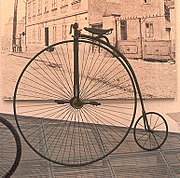






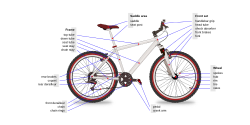



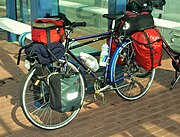





No comments:
Post a Comment